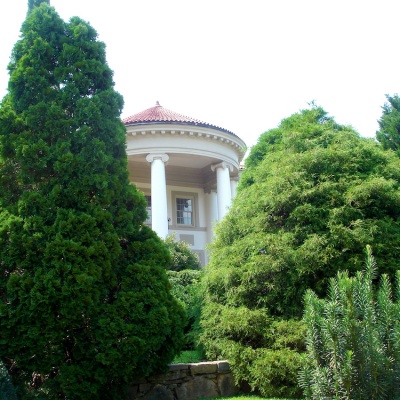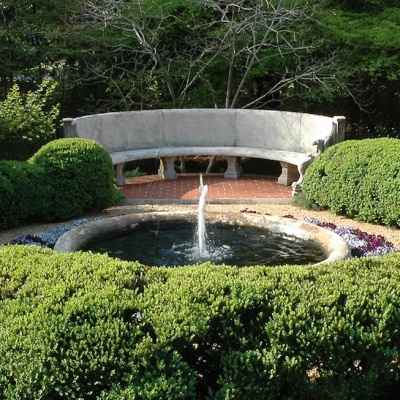An Eye for an Eye

A Hills & Dales guest once remarked of Alice Callaway’s sophisticated and frequently imaginative use of plants that…“she definitely had an eye for treatment!” The observation was made standing in front of a trio of Southern magnolias that were coerced at a pliable young age to bend around and frame the arched windows on the east wall of the estate garage. Training the trees in that manner created a focal backdrop for the courtyard area between the home, pool house and garage, and also softened the view of that large wall. This ‘treatment’, as it was called, is known as espalier and is just one of several striking design elements that Alice added to the garden and landscape.
Espalier is a French horticultural term that refers to growing plants flat against a structure such as a wall, fence, or trellis. It can be used both as a noun or verb to indicate the method used, the trained specimen itself, or the act of training a plant on an espalier framework. It’s been in practice since ancient times, done initially on fruit trees to allow for production in small spaces while also taking advantage of the protected microclimate that a wall can provide. Over the centuries several design patterns were developed that splendidly married the concepts of form and function. So much so that espalier has become an artistic gardening approach now applied to many woody ornamentals as well. The effect isn’t that difficult to achieve; it only requires the right kind of plant, some technique, plus perseverance and patience.
The list of suitable candidates for espalier is large enough to offer something that appeals to most anyone. In addition to fruit bearers like apple, fig, citrus and pear, trees such as Japanese maple, redbud, various hollies, and magnolia are popular choices. Shrub possibilities include camellia, quince, osmanthus, pyracantha, yew, plus many others. If tackling either of those groups seems too daunting, consider experimenting first on a woody vine. It might be a bit surprising to think of trellised vines as espalier, but they fit the definition, and their pliable stems coupled with a typically linear growth habit make them easy to train. There are many to choose from, with confederate jasmine, clematis, grapes, cross vine and native wisteria being just a few of the elegant options. Alice not only used the magnolias mentioned above, but also boxwood, quince, osmanthus, and a number of vines and pear. All but the latter are still extant and thriving. In fact, the most common question we’re asked about the courtyard magnolias is their age and, although an exact planting date hasn’t been found, we have determined this feature is at least fifty years old.
Experts agree that after selecting the site and the plant for one’s choice of espalier design, allowing a newly installed tree or shrub to become settled in for a year or so before extensive training begins is best. Vines are an exception, as they often need growth control and support very soon. Also, a couple of timing principles that generally apply call for pruning when appropriate for each flowering species, and shaping new growth during the growing season when it is flexible. Complete instructions for the different plant selections and patterns are readily available in books or online.
The last two requirements of perseverance and patience can only be provided by the caretaker, however. They’re qualities Mrs. Callaway astutely pronounced necessary for any good gardener, and she had them in spades, also adding acceptance to complete her trio of horticultural virtues. Using them to balance an adventurous spirit that grew as she gained experience and wisdom, her cultivation and design skills were honed over the six decades that she tended this garden. Perhaps that is the best way to attain “an eye for treatment!”
View this entire Portico Newsletter:


